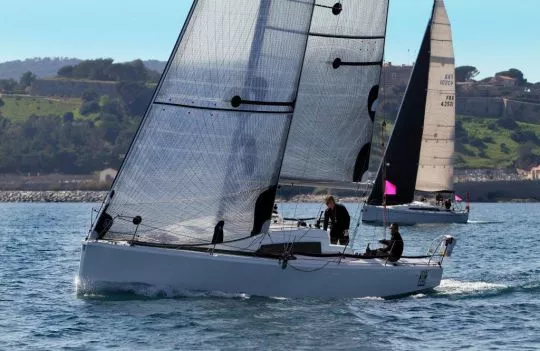Understanding Mainsail Adjustments
The mainsail serves as a vital element in sailing, generating propulsion for the sailboat. To enhance sailing efficiency, especially when battling against the wind, it’s essential to adjust the mainsail to suit varying wind conditions. This overview delves into the critical techniques for optimizing mainsail adjustments, ensuring a smoother sailing experience.
The Role of Mast Shape
The bending of the mast, often referred to as “mast bending,” is crucial since it influences the overall shape of the mainsail. The shrouds are responsible for holding the mast in its upright position, but they also modify its curvature. A more pronounced bend can flatten the sail shape, reducing its power. For instance, in lighter winds, keeping the mast straighter is advisable, while stronger breezes may necessitate a more curved mast.
How to adjust mast shape effectively:
For a two-stage spreader mast, utilize the intermediate shrouds (D2) to alter the curvature.
For a single spreader mast, the lower shrouds (D1) should be adjusted accordingly.
The backstay pulls the masthead backward, allowing for increased mast height, which can also modify sail shape.
It’s recommended to experiment with mast shape based on seasonal wind variations and conditions.
Tensioning the Halyard and Cunningham
The halyard isn’t just a tool for raising the sail; it plays a critical role in adjusting the mainsail’s shape. Often used in conjunction with the Cunningham, the halyard creates upward tension, while the Cunningham introduces downward pressure. Balancing these tensions allows the sailor to shift the position of the mainsail’s hollow, enhancing power and responsiveness.
Increasing halyard tension opens the sail’s leech, releasing power, which is particularly effective in higher winds. Conversely, relaxing this tension helps the sail gather more wind in lighter conditions, making it a handy tool for quick adjustments while on the water.
Modifying the Mainsail’s Foot
The foot of the mainsail extends along the boom. By tightening or loosening this section, one can effectively control the volume of the lower quarter of the sail. In higher winds, it’s common to stretch the foot more tautly, whereas, in lighter winds, a more relaxed adjustment will suffice.
This simple adjustment not only enhances control but can also optimize sailing speed and responsiveness, a key factor for sailors looking to improve their maneuverability.
Useful Mainsail Adjustment Tools
Efficient mainsail adjustment requires the right tools. Here are some essential items every sailor should have:
- Adjustable tensioners: Useful for proper halyard and Cunningham adjustments.
- Tension gauges: Allow for precise tuning of rig tension.
- Winches: Essential for applying the necessary tension to lines and sails.
- Soft shackles: Aids in quick adjustments without compromising strength.
- Sliders and bearings: Facilitate the smooth movement of the sail during adjustments.
Important Factors Influencing Mainsail Adjustments
While the tools above are critical, understanding the environment is equally vital. Factors like wind speed, direction, and sea conditions can greatly influence how adjustments should be made:
- Wind Speed: Sharp increases in wind speed may require immediate adjustments to sail shape to maintain control.
- Water Conditions: Choppy or smooth waters can change how the boat handles; adjustments might differ accordingly.
- Weather Patterns: Anticipating changes in weather can help plan adjustments in advance, ensuring a successful sailing experience.
The Adventure of Sailing and Boat Rentals
At GetBoat.com, the focus is on creating memorable experiences on the water. Staying informed on sailing techniques and best practices allows enthusiasts to truly enjoy their time on the sea. Whether it’s a relaxing day on a tranquil lake or an exhilarating journey through gusty coastal winds, effective mainsail management plays a pivotal role in navigating the unpredictable waters.
GetBoat embodies the spirit of freedom and adventure, offering a platform for clients to select the vessel that suits their needs, budget, and taste. The ability to experience sailing firsthand enhances the understanding and appreciation of these adjustments, ensuring that every trip is enjoyable and memorable.
Concluzie
Mastering mainsail adjustments is truly an art that combines knowledge, practice, and an appreciation for the wind and water. These adjustments are not merely technical but are essential for harnessing the full power of your boat, making the journey smoother and more enjoyable. Each sailor will discover that navigating new locations enhances their journey, connecting them to local cultures and the awe of nature.
If planning your next maritime adventure, consider the benefits of renting a boat. Each inlet and bay has a unique story to tell, enriching the sailing experience just as much as the local cuisine and scenery. For unforgettable boat experiences, visit GetBoat.com.
Importance of Mainsail Adjustments
Understanding how to adjust the mainsail significantly impacts overall sailing performance. By taking into account factors such as wind conditions and boat dynamics, sailors can enhance efficiency. As sailing encompasses various aspects—technical, cultural, and experiential—the journey brings to life the colors and rhythms of different locales.
So, whether sailing on the ocean, lakes, or rivers, let the allure of the sea guide your next adventure. Discovering new destinations is but a sail away with GetBoat’s diverse offerings, ensuring that the horizon always holds new possibilities. Happy sailing!


